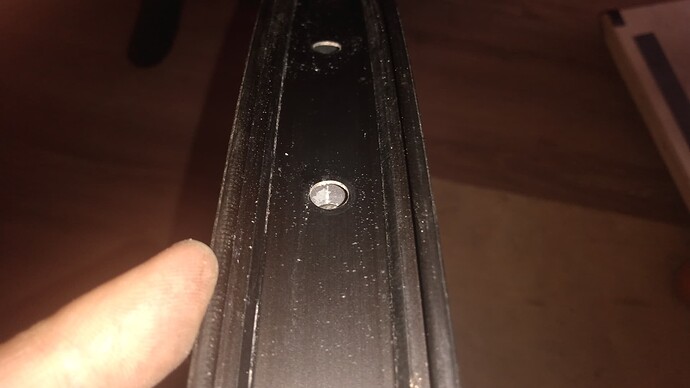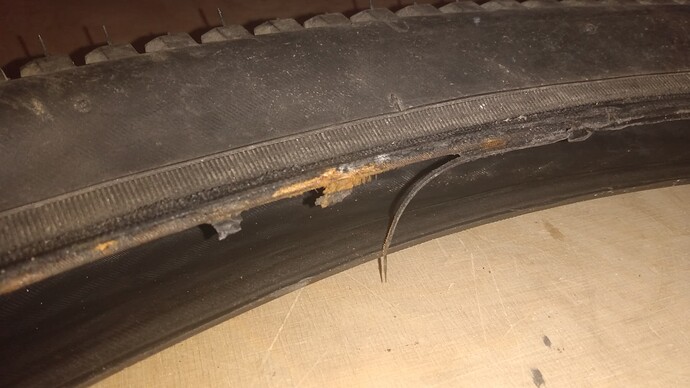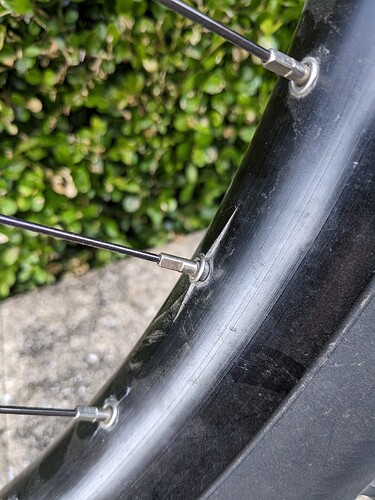Today I discovered some fractures at the spokeholes on my 36 rim.
One spoke without a fracture was a little slack, all other had still enough tension (about 800 Newton).
The rim is 3 years old and has 9000km. No hopping, muni or idling.
Has someone else a similar problem?
What spoke tension are you using?
As it is a first series Schlumpf hub about 800 Newton / 80 Kgf.
Tubeless?
No.
It is a mid-low tension in a normal setup. Maybe did you bought a used (and abused) rim? No way it should broke at that tension if you’re not doing drops
No it was new. No drops just road.
Curious.
Where was it built or did you build the wheel?
Can you see any direction of these cracks? Ok wondering if the torque from the high gear perhaps puts greater tension on the spoke holes.
No engineer here just curious. What version of hub is this? The coterless one?
I’ve personally not yet seen a failure of a Stealth II/Dominator 36" rim, even with some quite heavy and exuberant riders, although admittedly fewer miles than that.
It’s definitely not an unknown failure mode of aluminium rims but still pretty uncommon.
What tyre pressure do you run? With your tyre fully inflated, what tension do you read on the spokes, or if that’s what you measured, what tension do you read with the tyre deflated?
Do you have particularly harsh riding conditions/seasons that could have an effect?
It is the cotterless hub, with the outside torque support and schlumpf frame. The cracks are all in the centerline of the rim. I built the wheel and the tensionmeter was calibrated with the same spokes the wheel is built.
I never put off the tire, so I don,t know how it looks inside. Maybe there is some corrosion because I also use the uni in winter when we have salt on the road.
I suspect they are cracks caused by stress fractures, accelerated by the winter salts.
That rim is anodised, but from memory I think it’s done before it’s drilled so salt water will sit under the rivets on the uncoated aluminium, slowly corroding the metal and speeding up fracturing.
Have you looked on the inside to see if the crack goes through? Could it be just a surface crack in the finish? If the crack was actually through and through I would expect to see some separation in the crack, along with the spoke hole eyelets pulling up.
Going off what Unigeezer said, maybe the spokes have warped the rim ever so slightly around the eyelets/holes and the surface finish/anodized layer cracked. From the picture it looks superficial only.
Agree
The spoke torque of 800 newton was at a pressure of 42psi.
Without air it was about 10% higher. I think thats normal and ok.
Normally i use a pressure between 40 and 50 psi, in winter about 35 psi.
I put off the tire and yes the cracks are through.
You can see the oxidation along the cracks. It looks similar to the outside before i removed the white oxidation. Oxidation because the anodisation is damaged at the crack.
But putting off the tyre i saw next problem:
The steal wire of the nimbus nightrider light has got out of the rubber.
Maybe a damage from mounting the tyre. I mounted the tyre just two times. First with a 36 tube when it was new. One week later i changed the tube to a continental 29mtb. This on was inside for more than 9000km without any issues.
I put the tyre back onto the rim and it is ok.
So i think i need a new rim and a new tyre when i will cange my hub.
Unless you have pounded this rim to with in an inch of it’s life, which is possible, I’m convinced it is in the finish. Google cracks in anodized finishes and you will find lots of info. It can an come from the aluminum sub structure and the anodized finish flexing at different rates. Also could be a substandard anodizing at the factory level. You could pick one crack and grind below the surface to see how deep it goes then touch it up with some black paint. Unless your hell bent on a show uni, if it is safe, I say live with it.
I’ve never seen a crack in an anodised finish that looks like that unless the underlying aluminium is cracked.
Crazing in anodising is relatively common, but it looks very different to a straight crack.
I’m still inclined towards it being fatigue cracks that have had their growth accelerated due to the addition of a (probably quite high concentration over time) saline solution. This is a relatively well known phenomenon.
I was going to suggest running your finger over the crack to see what you could detect, but the limits of tactile perception are (incredibly) apparently orders of magnitude smaller than the typical height of an aluminium anodising layer, so even if you can feel something, it wouldn’t tell us much.
Shure you can feel the crack. There are cracks at about 10 spockeholes and only at these are the white lines inside of the rim. Inside you cannot scratch in this way. So i am shure they are though. But i don´t believe that there will be a sudden problem while riding, causing a fall. So i will use it until i get the new hub.
And the cost of riding. Rims are a consumable, just like tires although usually at a slower rate. Andy



